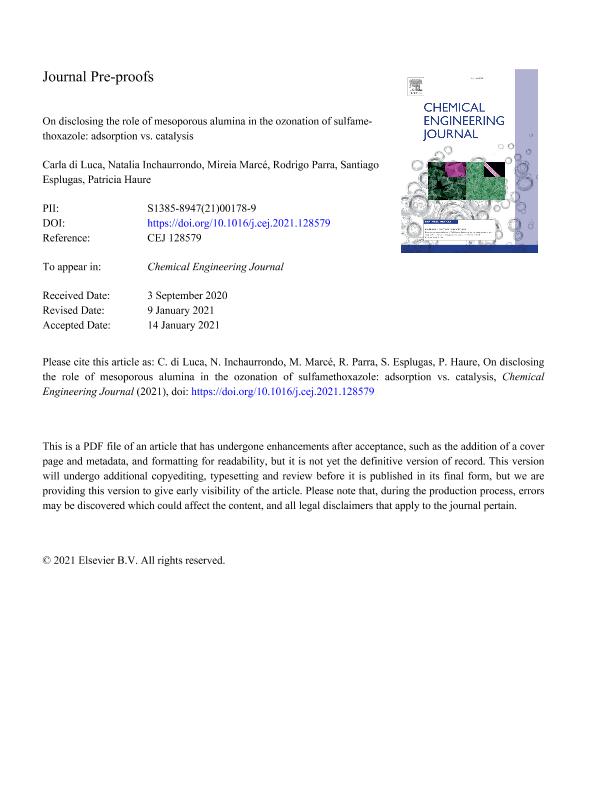Artículo
On disclosing the role of mesoporous alumina in the ozonation of sulfamethoxazole: Adsorption vs. Catalysis
Di Luca, Carla ; Inchaurrondo, Natalia Soledad
; Inchaurrondo, Natalia Soledad ; Marcé, Mireia; Parra, Rodrigo
; Marcé, Mireia; Parra, Rodrigo ; Esplugas, Santiago; Haure, Patricia Monica
; Esplugas, Santiago; Haure, Patricia Monica
 ; Inchaurrondo, Natalia Soledad
; Inchaurrondo, Natalia Soledad ; Marcé, Mireia; Parra, Rodrigo
; Marcé, Mireia; Parra, Rodrigo ; Esplugas, Santiago; Haure, Patricia Monica
; Esplugas, Santiago; Haure, Patricia Monica
Fecha de publicación:
05/2021
Editorial:
Elsevier Science
Revista:
Chemical Engineering Journal
ISSN:
1385-8947
Idioma:
Inglés
Tipo de recurso:
Artículo publicado
Clasificación temática:
Resumen
Ordered mesoporous alumina (MA) and Fe-doped MA were synthesized by evaporation-induced self-assembly and tested for the ozonation of sulfamethoxazole (SMX). The synthesis methodology produced MA whose surface and structural properties exceeded those of commercial types displaying a BET surface area of 263 m2/g, a pore volume of 0.8 cm3/g and aligned cylindrical pores of c.a. 10 nm. The ozonation of SMX (20 mg/L) was performed in a semibatch stirred tank reactor at: T = 22 °C, [O3]gas = 10 mg/L, Qgas = 42 L/h NTP, [solid] ≈ 1 g/L, t = 120 min. Single ozonation achieved fast and complete SMX removal and mineralized up to 35% of the organics at neutral pH. The addition of MA or Fe-doped MA did not affect the removal rate of SMX, but did achieve a remarkable TOC removal up to 86% at acid pH. However, under the selected operating conditions, ferric species did not improve the removal of organic matter. Then, the adsorption and catalytic contribution of MA was evaluated in specifically-designed experiments. While SMX adsorption was low, its oxidation intermediates did adsorb onto MA surface. Despite the high ability of the materials to decompose ozone, the results revealed that the by-products adsorption is the prevailing process for the TOC removal. After four successive reuses, MA reduced its adsorption performance due to chemisorption of carboxylates. Nevertheless, the worn material was regenerated by direct ozonation in gas phase. In addition, primary transformation products were identified by LC–ESI–TOF–MS and the scavenging effect of the water matrix was assessed using bottled water and a real secondary wastewater.
Palabras clave:
OZONIZACIÓN
,
ALÚMINA MESOPOROSA ORDENDA
,
CONTAMINANTES EMERGENTES
,
ADSORCIÓN
Archivos asociados
Licencia
Identificadores
Colecciones
Articulos(INTEMA)
Articulos de INST.DE INV.EN CIENCIA Y TECNOL.MATERIALES (I)
Articulos de INST.DE INV.EN CIENCIA Y TECNOL.MATERIALES (I)
Citación
Di Luca, Carla; Inchaurrondo, Natalia Soledad; Marcé, Mireia; Parra, Rodrigo; Esplugas, Santiago; et al.; On disclosing the role of mesoporous alumina in the ozonation of sulfamethoxazole: Adsorption vs. Catalysis; Elsevier Science; Chemical Engineering Journal; 412; 128579; 5-2021; 1-66
Compartir
Altmétricas



